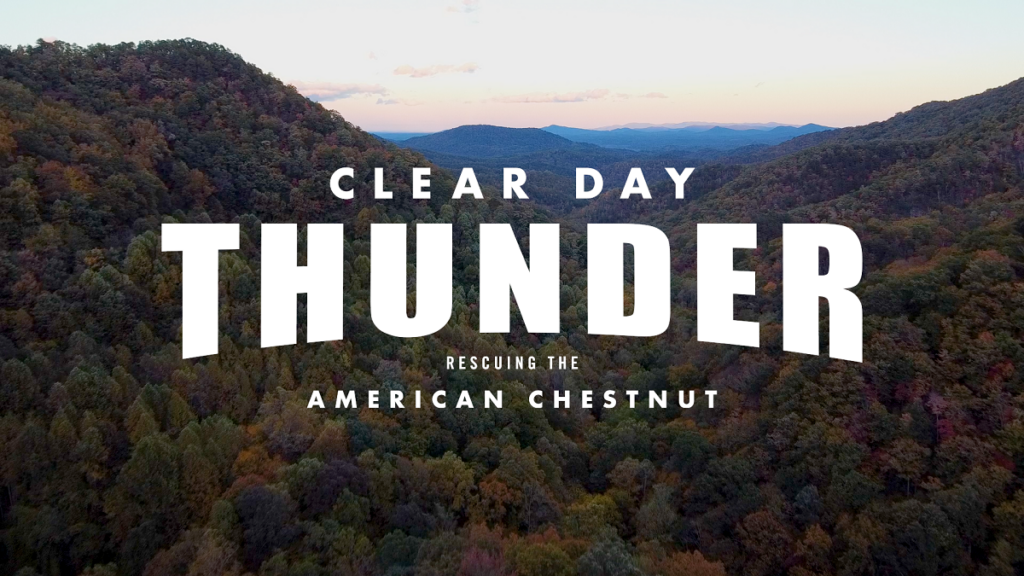
There are many discouraging stories when it comes to our native tree species these days: Emerald Ash Borer, Hemlock Woolly Adelgid, and Beech Leaf Disease, to name a few. The story of the American Chestnut, however, has had a much more positive trajectory in recent years, mainly thanks to the work of the American Chestnut Foundation, which is celebrating its 40th anniversary in 2023. The new documentary, Clear Day Thunder: Rescuing the American Chestnut, chronicles this story, and we are holding a screening of the film on Sunday, October 15, 3 pm, at Gilsland Farm Audubon Center in Falmouth. (Get tickets here >)
American Chestnut (Castanea dentata) was a significant tree both in Maine and much of eastern North America prior to 1900. The vast forests stewarded by the indigenous peoples of the continent were dominated by fire-tolerant species, like oaks, pines, hickories, and American Chestnut, due to the widespread use of fire for landscape management. This indigenous management created forests with abundant nut crops, which was dominated by chestnuts in many places, partly due to American Chestnut’s habit of yearly cropping, rather than every few years like oaks or hickories. These abundant crops of chestnuts sustained both the indigenous peoples and the animals that they depended on, like deer, turkeys, and bears.
In the late 19th century, however, some Japanese Chestnut trees (C. crenata) were brought to North America, unknowingly infected with the Chestnut Blight Fungus (Cryphonectria parasitica). Asian chestnuts have coevolved with this fungus and are generally resistant to its effects, but American Chestnuts have no resistance to the fungus and become quickly infected, girdled, and eventually killed. This was first noticed at what is now the Bronx Zoo in 1904, and in two years, 98% of the chestnut trees in the borough were infected. The fungus would spread rapidly throughout the continent, killing nearly three billion trees in a few decades. Today, there are almost no chestnuts left in their native range, though some persist as root systems that continue to resprout (since the fungus girdles the tree above ground, the root systems are generally unharmed).
This all began to change with the work of the American Chestnut Foundation. It was formed in 1983 by a group of prominent plant scientists, with the aim of breeding a blight-resistant American Chestnut. The original effort to achieve this goal was through back-crossing: American Chestnuts were hybridized with Chinese Chestnuts (C. mollissima) to produce 50-50 hybrids, then the offspring crossbred with American Chestnuts, to produce offspring with increasingly higher proportions of American Chestnut genetics, while retaining the blight resistance of Chinese Chestnuts. This method is effective, though extremely time-consuming due to trees’ long life cycles: it took from 1989 to 2005 to produce potentially blight-resistant chestnuts with this method.
Thankfully, advances in genetic engineering allow a much faster and more targeted method: inserting specific genes conveying blight resistance directly into the American Chestnut genome. This is exactly the method utilized by a group based at SUNY’s College of Environmental Science and Forestry, which has produced the ‘Darling’ American Chestnut. This group looked at a number of potential genes to convey blight resistance, and found that a gene from bread wheat (also found in many other plants) was most effective. By adding this gene to the approximately 40,000 others in the American Chestnut genome, they developed a tree that is 99.999% American Chestnut and fully blight-resistant in a fraction of the time that back-crossing took. The American Chestnut Foundation has incorporated support for this strategy in a three-pronged approach to restoration.
Clear Day Thunder tells much of this story, with a star-studded cast of passionate environmentalists and conservationists. Join us on October 15 to celebrate 40 years of work by the American Chestnut Foundation and the continued effort to restore this native tree to our forests.
